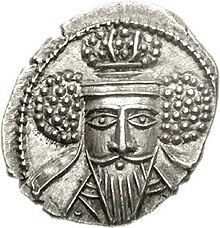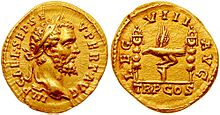Vologases V
| Vologases V 𐭅𐭋𐭂𐭔 | |
|---|---|
| King of Kings | |
 Coin of Vologases V, Ecbatana mint | |
| King of Armenia | |
| Reign | 180 – 191 |
| Predecessor | Sohaemus |
| Successor | Khosrov I |
| King of the Parthian Empire | |
| Reign | 191 – 208 |
| Predecessor | Vologases IV |
| Successor | Vologases VI |
| Died | 208 |
| Issue |
|
Arsacid dynasty | |
| Father | Vologases IV |
| Religion | Zoroastrianism |
Vologases V (
Vologases' reign was marked by war with the Roman Empire, lasting from 195 to 202, resulting in the brief capture of the Parthian capital of Ctesiphon, and reaffirmation of Roman rule in Armenia and northern Mesopotamia. At the same time, internal conflict took place in the Parthian realm, with the local Persian prince Pabag seizing Istakhr, the capital of the southern Iranian region of Persis.
Name
Vologases is the Greek and Latin form of the Parthian Walagaš (𐭅𐭋𐭂𐭔). The name is also attested in New Persian as Balāsh and Middle Persian as Wardākhsh (also spelled Walākhsh). The etymology of the name is unclear, although Ferdinand Justi proposes that Walagaš, the first form of the name, is a compound of words "strength" (varəda), and "handsome" (gaš or geš in Modern Persian).[1]
Biography
King of Armenia
During Vologases' early life, he became the ruler of
In 189, he also imposed his son
King of the Parthian Empire
In 191 after the death of his father

Vologases supported Emperor
In 202, peace was restored, reaffirming Roman rule in Armenia and northern Mesopotamia.
Vologases died in 208, succeeded by his son
Notes
- ^ According to the 5th-century Armenian historian Agathangelos, the king of Armenia had the second rank in the Parthian realm, below only to the Parthian king.[6] However the modern historian Lee E. Patterson suggests that Agathangelos may have exaggerated the importance of his homeland.[7]
References
- ^ a b c d e Chaumont & Schippmann 1988, pp. 574–580.
- ^ a b c Toumanoff 1986, pp. 543–546.
- ^ a b Patterson 2013, pp. 180–181.
- ^ Russell 1987, p. 161.
- ^ Lang 1983, p. 517.
- ^ Patterson 2013, pp. 180, 188.
- ^ Patterson 2013, p. 188.
- ^ Rapp 2014, p. 240.
- ^ Rapp 2017, p. 240.
- ^ Patterson 2013, p. 181 (see also note 18).
- ^ Sellwood 1983, p. 297.
- ^ a b c Dąbrowa 2012, p. 177.
- ^ a b c d Daryaee 2010, p. 249.
- ^ Dąbrowa 2012, p. 187.
- ^ Daryaee 2012, p. 187.
- ^ Patterson 2013, p. 177.
Sources
- Chaumont, M. L.; Schippmann, K. (1988). "Balāš". In ISBN 978-0-71009-118-5.
- Dąbrowa, Edward (2012). "The Arsacid Empire". In ISBN 978-0-19-987575-7. Archived from the originalon 2019-01-01. Retrieved 2019-01-13.
- Daryaee, Touraj (2010). "Ardashir and the Sasanians' Rise to Power". Anabasis. University of California: 236–255.
- ISBN 978-0199732159.
- Lang, David M (1983). "Iran, Armenia and Georgia". In ISBN 0-521-20092-X..
- Patterson, Lee E. (2013). "Caracalla's Armenia". Syllecta Classica. 2. Project Muse: 27–61. S2CID 140178359.
- Rapp, Stephen H. (2014). The Sasanian World through Georgian Eyes: Caucasia and the Iranian Commonwealth in Late Antique Georgian Literature. Ashgate Publishing, Ltd. ISBN 978-1472425522.
- Rapp, Stephen H. (2017). "Georgia before the Mongols (2017)". Oxford Research Encyclopedia of Asian History. Oxford University Press: 1–39.
- ISBN 978-0674968509.
- Sellwood, David (1983). "Parthian Coins". In ISBN 0-521-20092-X.
- Toumanoff, C. (1986). "Arsacids vii. The Arsacid dynasty of Armenia". In ISBN 978-0-71009-105-5.
Further reading
- ISBN 978-0199733309.
